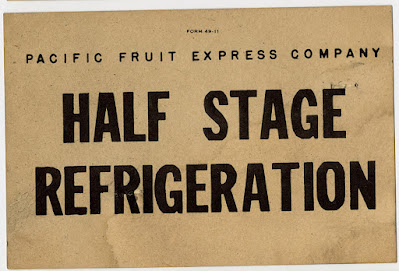In roughly ten immediately previous posts in this series about route cards (or other cards typically affixed to the route card board on the side of a freight car), I have shown routing cards, directing a car to some destination; grading cards, reflecting an inspection of the car interior for suitability for various kinds of loads; and other cards, directing other car needs, such as cleaning out. But there are still more kinds of cards that might be seen. This post is about cards for ice refrigeration.
Most of what I show today is again from Michael Litant’s collection. I greatly appreciate his generosity in loaning these to me and giving permission for me to post them in this blog.
I will begin with a real clear legend on a card directing service for a car with a particular need. It’s from the Santa Fe and is 3.5 inches square. No car identification is needed on a card like this.
Another card reflecting icing is this Pacific Fruit Express card identifying that the car is set up for half-stage icing. It is 4 x 6 inches in size. Essentially the same card, provided by Ralph Heiss, was shown in an earlier post on this topic (located here: http://modelingthesp.blogspot.com/2016/07/route-cards-part-12-more-examples.html ). Like the card above, it is likely that this card would have been placed on what was called the “commodity card board,” not on the route card board.
Some readers no doubt are mumbling to themselves, “what the heck is a commodity card board?” These are visible on steel reefers after about 1950, as I show for PFE Class R-40-26 below (PFE photo, courtesy CSRM ). The large, upper board to the left of the door is the placard board, the smaller one below it is the commodity card board. (These boards have sometimes been called “auxiliary placard boards.”) The route card board is just visible on the left bolster, below and to the left of the fan plate. You can click on the image to enlarge it.
I’ve described modeling these boards in an earlier blog post (you can see it at: http://modelingthesp.blogspot.com/2013/09/a-classic-ho-scale-car-kit-one-more-time.html ).
For another example of a card that might well be located on the commodity card board, below is another stage icing card, this one not identified as to issuing railroad or car owner. It is only 1 x 4 inches.
I should perhaps mention what “stage icing” or “half-stage icing” was. The ice grates at the bottom of the ice bunker supported the ice while allowing meltwater to drain. In a car equipped for half-stage icing, the grates could be moved upwards to rest on a support on the wall between the bunker and the car interior. Then the standard icing process, filling the bunker to the top, used less ice.
For more on stage icing, use of salt, and other operational matters, see the PFE book (Pacific Fruit Express, 2nd edition, Signature Press, 2000), particularly Chapters 8, 14 and 15.
Another consequence of conventional ice refrigeration was that in cold weather, heating was needed instead of cooling. This was accomplished by placing heaters in the ice bunkers, originally charcoal burning, later kerosene or propane. But combustion in a sealed enclosure like a reefer meant that carbon monoxide would be generated. Thus placards like this were placed on placard boards, and sometimes also on ice hatch covers. It’s 7 x 9 inches in size.
Finally, an interesting card directing the addition of salt to a reefer (REX 7499, a 54-foot express reefer); it calls for 3% salt. This is a Railway Express Agency card, interesting in itself. It is 4 x 6 inches, and was issued at Yakima, Washington on June 17, 1966. The cargo is identified as cherries, consistent with that date. I like the seemingly redundant instruction, “If no salt is to be used, do not attach salt card.”
All these cards reflect what was called “protective services” in the tariff books, both icing arrangements and additions of salt. Since I’m something of a reefer enthusiast myself, these are especially interesting to me, and I am contemplating how and when to model some of these for operations on my layout.
Tony Thompson






I really appreciate the whole waybill and route card series of information - great work, enjoy all of the info., much of which I have been able to apply to my layout operating schema. Thanks again.
ReplyDelete